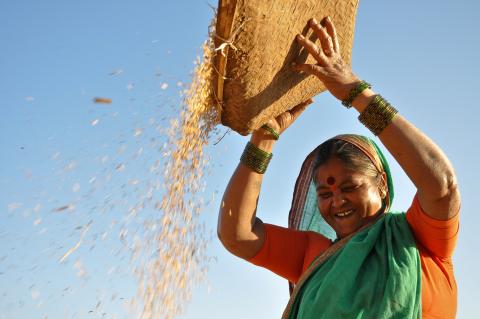“Rice consumption patterns are shifting”: An interview with Catur Utami Dewi
An expert, with two decades of working in sustainable agriculture, inclusive markets and food systems, talks about the challenges and the way forward for the global rice sector.
Catur Utami Dewi is the Global Rice Programme Director of Rikolto. Her Belgian non-profit organisation is an institutional member of the Sustainable Rice Platform (SRP), working in sustainable food systems in 17 countries. She oversees their rice programmes in 8 countries in Asia and Africa.
Previously, as Rikolto’s Regional Director in Indonesia, she managed the organisation and its programmes on sustainable and quality-assured rice, cocoa, coffee, cinnamon, and Food Smart Cities in Indonesia. Dewi is also a board member of Preferred by Nature and a board member of SRP which she represents in the ECOWAS Rice Observatory.
We spoke with Ms Dewi to understand more about the worldwide rice industry's trends, challenges, and potential solutions, and look into the areas where the rice sector is lacking and how to close those gaps to make the rice sector sustainable.

In your view, why is rice such an important commodity?
From an economic and nutritional point of view, being grown in more than 100 countries, rice is a significant global commodity. Whether as a source of income or a staple diet, rice plays a significant part in the lives of billions of people. Globally some 500 Mio. metric tons of rice have been consumed in 2020/21. More than 16% of the calorie intake of the world’s population comes from rice, only maize delivers more. 3.5 billion people have rice as their staple food, and that number is expected to increase by 25% by the year 2050. The rice sector provides a living for more than 20% of the world’s population.
Also, rice is both a victim of and a contributor to climate change. Each growing season, crops are prone to droughts, floods, saltwater intrusion, adverse temperatures etc., affecting the livelihoods of smallholder rice farmers. On the other hand, rice production emits 4kg CO2-e and needs 1,400 litres of water for every 1kg produced.
What are the current trends in the rice sector at the global level?
Agroecology, sustainable food systems and a sustainable rice sector draw more attention. Countries start to include their agricultural sector, some specifically including rice, in their strategies to reduce emissions and impacts of climate change to reach Nationally Determined Contribution targets under the Paris Agreement.
Rice consumption patterns are shifting. For example, in countries such as Indonesia, Vietnam and Japan, where rice is traditionally a daily staple food, people are diversifying their diet and food preferences. Therefore, the average rice consumption per capita decreases.
In Africa on the other hand, the consumption of rice is increasing. It is becoming accessible and affordable and its preparation in the kitchen is much easier than the traditional staples and saves time. In our partner country Senegal e.g., rice was previously only consumed on special occasions, but is now included in the regular diet. Overall, the rice demand increases with the growing world population.
In your view, what are the key challenges the rice sector encounters, and how can we tackle them?
To meet the steadily increasing demand for rice without reducing its quality or creating an excessive ecological burden, the transformation of the rice sector to greater sustainability is vital to provide affordable and safe food for consumers, create decent jobs and income for smallholder farmers including women and youth, and reduce environmental impacts.
With respect to labour as the productive factor, a serious problem is that the majority of farmers are above 50 years old. In order to make the necessary quantity of labour available, we need therefore to discover ways of making rice growing and the rice business more attractive to both men and women as well as especially youths. Also, the quality of labour (human capital) in the rice sector must be upgraded.
Therefore, to reduce the substantial knowledge gap, farmers need access to training and skill development, knowledge enhancement, adoption of innovative agricultural methods, and use of appropriate technology. Improved production practices accompanied by access to quality inputs will help to enhance production, reduce costs and improve farm resilience. One of the important areas that need to be included in the training of the farmers is how to adapt to climate change.
Mechanisation can improve production processes, reduce drudgery and make the work more attractive and efficient. The addition of new and improvement of available physical capital like tools and machinery is important. Investment to improve production, however, needs sufficient access to finance. Numerous institutions, both public and private, are aware of this and are looking for ways to support smallholder farmers, especially women, to access funds and deliver agriculture insurance schemes for risk reduction.
Another important element of our concept is working to promote enabling policies and programmes of the public and private actors to promote sustainable rice. With this approach, we can demonstrate success and convince other actors to follow suit, adapt and tailor it to their situation and context.
Rice has a large group of consumers by number. What role can consumers play to help make rice more sustainable?
In addition to preferences for healthy food, more and more consumers become aware of agroecological issues. They demand the design and management of our food systems to balance natural resource use and environmental protection with the needs of production, economic viability, food security, and the social well-being of all people.
Consumer education can further this process. If they are informed about the production processes of rice, they ideally should demand rice that is grown in a healthy, environmentally and socially responsible manner and ensure its sustainable consumption. Rice millers, wholesalers, traders, and industry may all play a significant part here in reaching out to rice consumers, amplifying their contribution, and ensuring the rice industry's sustainability. Also, private and government sectors should work hand in hand.
This transformation of consumptive behaviour will most likely begin in increasingly affluent societies, where people are willing and able to pay a fair price for food.
How can we achieve sustainability in the rice sector as we move forward?
Rice contributes to greenhouse gas emissions on a large scale. As mentioned, the total greenhouse gas emissions from producing one kilogramme of rice include four kilogrammes of CO2-e. Considering that scale, interventions are required to reduce this amount. The utilisation of waste products from operations, such as straw and how to use it in a way that prevents burning, can help reduce greenhouse gas emissions and promote a circular economy. This can be done by improving management practices in the rice value chain, which includes production, processing, transportation, and other areas.
If farmers produce rice in an equitable way to fulfil the rising demand with fewer harmful effects on the environment, sustainability can be achieved in the rice sector. This should also be beneficial to farmers and rice producers. Sustainability in the rice sector should make it more attractive to farmers, not less. This includes especially the income of farmers.
So, what advantages would farmers get if they adopt sustainable agriculture practices?
To increase profit (given constant prices), one either must produce more with one’s inputs or produce the same amount with less inputs. This means reducing production costs. In both cases, improved production processes are the key. Additionally, temporary subsidies, for instance, can be used as incentives. Good agricultural practices following the Sustainable Rice Platform (SRP) Standard in rice cultivation can increase farmers’ income by 10-20%, mainly by reducing production costs. However, when the productivity level is low, higher income may come from increased productivity. Farmers will also benefit from less exposure to excessive chemical inputs. In addition, they can benefit from healthier rice from their farm for their own consumption.
What recommendation would you like to give for Preferred by Nature to make an impact in the rice sector?
Preferred by Nature's focus is on ensuring sustainability in the industries it is active. It has the knowledge, expertise, and experience to contribute significantly to meeting the challenges of the rice industry.
To create a genuine impact, Preferred by Nature should work with other stakeholders, organisations, governments, and institutions. Collaborative efforts, networking, and policy advocacy are required to bring sustainability to the rice sector. Rikolto’s Global Rice Programme is happy to partner with Preferred by Nature wherever it makes sense and is beneficial for the rice sector.
Disclaimer: The author’s views expressed here are personal and do not reflect the views of Preferred by Nature.
